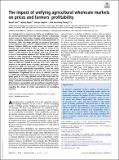| dc.contributor.author | Levi, Retsef | |
| dc.contributor.author | Rajan, Manoj | |
| dc.contributor.author | Singhvi, Somya | |
| dc.contributor.author | Zheng, Yanchong | |
| dc.date.accessioned | 2021-04-05T21:13:34Z | |
| dc.date.available | 2021-04-05T21:13:34Z | |
| dc.date.issued | 2020-01 | |
| dc.date.submitted | 2019-04 | |
| dc.identifier.issn | 0027-8424 | |
| dc.identifier.issn | 1091-6490 | |
| dc.identifier.uri | https://hdl.handle.net/1721.1/130379 | |
| dc.description.abstract | As a leading effort to improve the welfare of smallholder farmers, several governments have led major reforms in improving market access for these farmers through online agricultural platforms. Leveraging collaboration with the state government of Karnataka, India, this paper provides an empirical assessment on the impact of such a reform—implementation of the Unified Market Platform (UMP)—on market prices and farmers’ profitability. UMP was created in 2014 to unify all trades in the agricultural wholesale markets of the state to be carried out within a single platform. By November 2019, 62.8 million metric tons of commodities valued at $21.7 billion (USD) have been traded on UMP. Employing a difference-in-differences method, we demonstrate that the impact of UMP on modal prices varies substantially across commodities. In particular, the implementation of UMP has yielded an average 5.1%, 3.6%, and 3.5% increase in the modal prices of paddy, groundnut, and maize. Furthermore, UMP has generated a greater benefit for farmers who produce higher-quality commodities. Given low profit margins of smallholder farmers (2 to 9%), the range of profit improvement is significant (36 to 159%). In contrast, UMP has no statistically significant impact on the modal prices of cotton, green gram, or tur. Using detailed market data from UMP, we analyze how features related to logistical challenges, bidding efficiency, in-market concentration, and the price discovery process differ between commodities with and without a significant price increase due to UMP. These analyses lead to several policy insights regarding the design of similar agri-platforms in developing countries. | en_US |
| dc.language.iso | en | |
| dc.publisher | National Academy of Sciences | en_US |
| dc.relation.isversionof | http://dx.doi.org/10.1073/pnas.1906854117 | en_US |
| dc.rights | Article is made available in accordance with the publisher's policy and may be subject to US copyright law. Please refer to the publisher's site for terms of use. | en_US |
| dc.source | PNAS | en_US |
| dc.title | The impact of unifying agricultural wholesale markets on prices and farmers’ profitability | en_US |
| dc.type | Article | en_US |
| dc.identifier.citation | Levi, Retsef et al. "The impact of unifying agricultural wholesale markets on prices and farmers’ profitability." Proceedings of the National Academy of Sciences 117, 5 (January 2020): 2366-2371. © 2020 National Academy of Sciences | en_US |
| dc.contributor.department | Sloan School of Management | en_US |
| dc.relation.journal | Proceedings of the National Academy of Sciences | en_US |
| dc.eprint.version | Final published version | en_US |
| dc.type.uri | http://purl.org/eprint/type/JournalArticle | en_US |
| eprint.status | http://purl.org/eprint/status/PeerReviewed | en_US |
| dc.date.updated | 2021-03-19T13:07:30Z | |
| dspace.orderedauthors | Levi, R; Rajan, M; Singhvi, S; Zheng, Y | en_US |
| dspace.date.submission | 2021-03-19T13:07:31Z | |
| mit.journal.volume | 117 | en_US |
| mit.journal.issue | 5 | en_US |
| mit.license | PUBLISHER_POLICY | |
| mit.metadata.status | Complete | |
